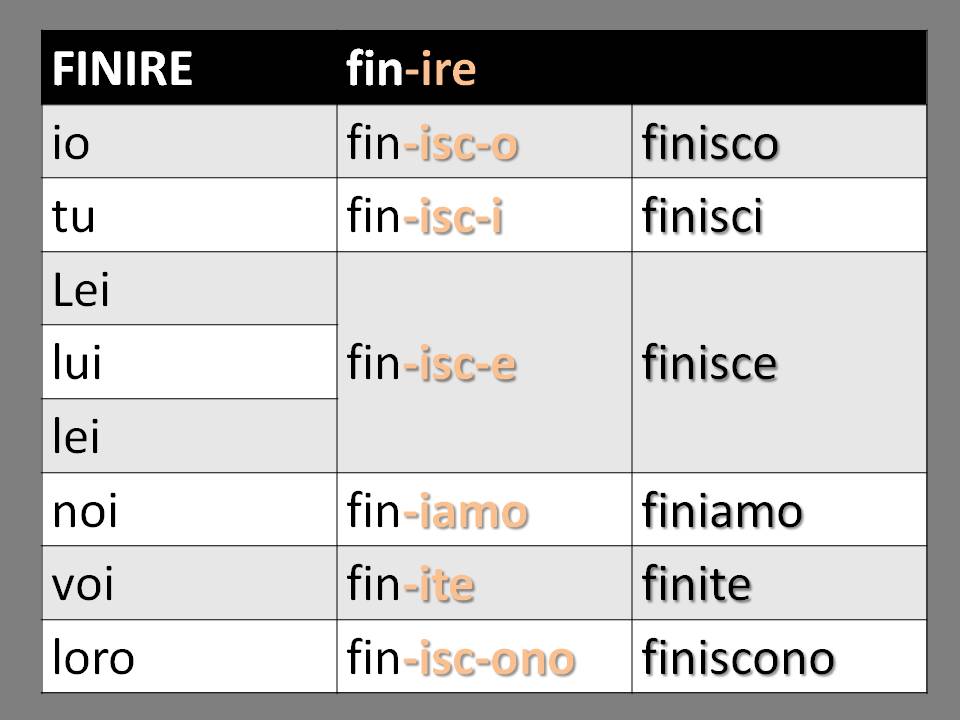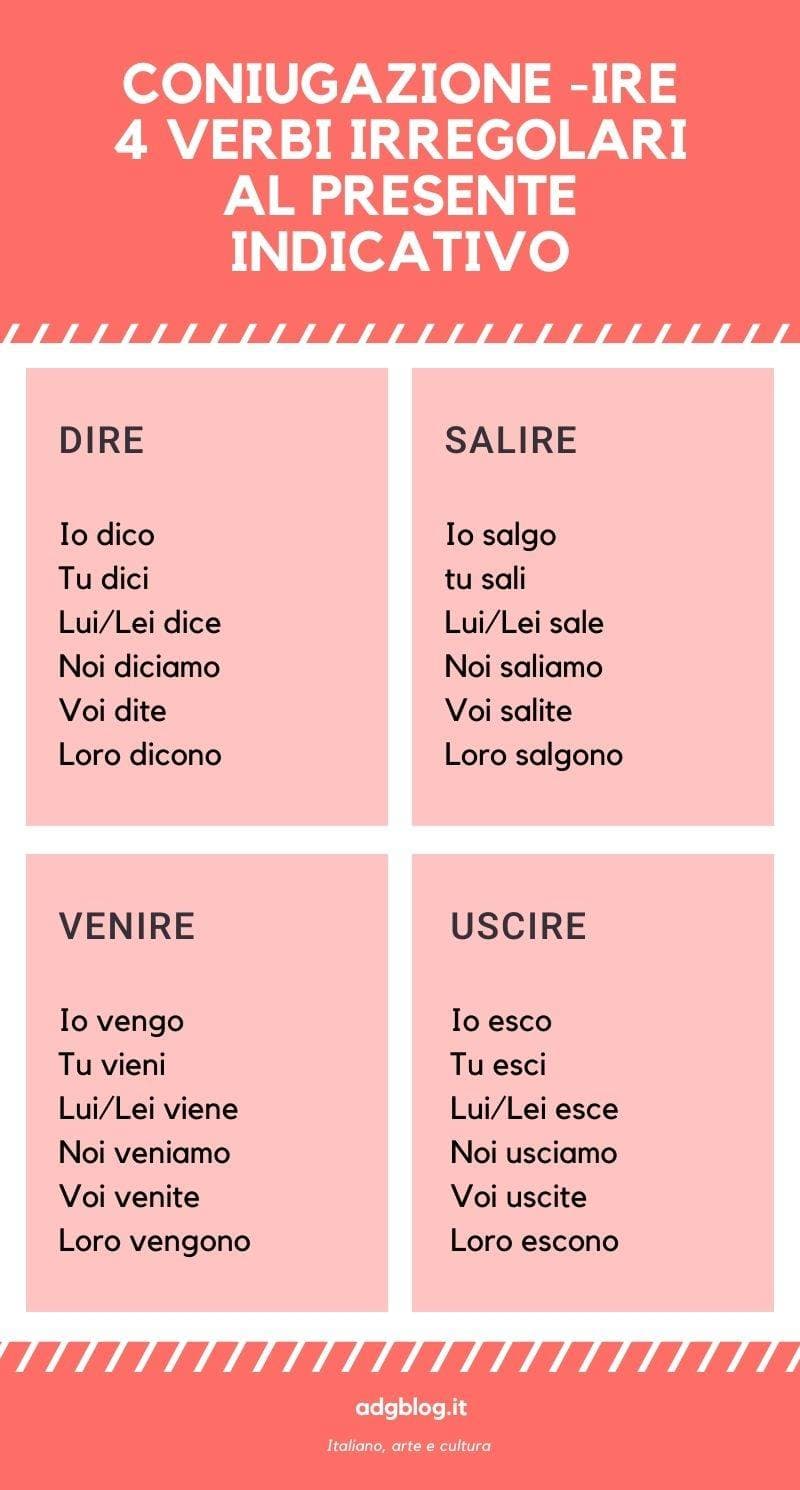Verbi In Are Ere Ire grinderworld

Presente indicativo dei verbi regolari
Verbi regolari (-are, -ere, -ire) - Futuro. Tag Futuro, Verbi regolari; Il futuro si usa per: - Per fare progetti → es: Quest'estate andremo al mare! - Per fare previsioni → es: Secondo me, Giuseppe andrà in prigione.

Verbi in tasca Italian words, Italian phrases, Learning italian
G3.1 - I verbi regolari e irregolari in - ERE. The present indicative of verbs ending in -ere i s formed by dropping the -ere and adding the ending that corresponds to the subject that is doing the action. As shown in the following chart, the endings for the forms io / tu / noi are the same as in the verbs ending in -are; the ending for.

Le tre coniugazioni ARE/ERE/IRE al coniuntivo (PRESENTE/PASSATO
Verbi regolari nel tempo presente del modo indicativo endings: example: endings: example: endings: example: infinitive-are: studiare (to study)-ere: leggere (to read)-ire: dormire (to sleep) (I) io-o: studio-o: leggo-o: dormo (you) tu-i: studi-i: leggi-i: dormi (he) lui (she) lei-a: studia-e: legge-e: dorme (we) noi-iamo: studiamo-iamo.

Esercizi Italiano L2 COOPERATIVA SOCIALE A.ME.LIN.C.
Molti verbi in -ire, anche se per gli altri aspetti sono regolari, rispetto alla coniugazione in tabella inseriscono l'infisso -isc tra la radice e la desinenza nella prima e seconda persona singolare, e nella terza persona singolare e plurale del presente (per esempio sancire, pulire o finire: io finisco, tu finisci, egli finisce, essi finiscono) e dell'imperativo (finisci, finisca.

Presente dei verbi regolari
Gran parte dei verbi regolari della terza coniugazione in -IRE (circa 500) vuole l'inserimento dell'interfisso -ISC- tra la radice e la desinenza nelle persone singolari e nella terza persona plurale dell'indicativo presente, del congiuntivo presente e dell'imperativo.

Verbi Regolari Italian with Nicco Dite!
Italian -ire verbs (also called 3rd conjugation) are the least common type in terms of quantity. But the few of them that exist are used quite frequently. -ire Verbs / I Verbi di -ire - Learn Italian with Polly Lingual

Verbi Regolari Italian with Nicco Dite!
Regular verbs in -ere and -ire The present tense of regular verbs in - ere is formed by dropping the infinitive ending (- ere ) and adding the appropriate endings to the resulting root (- o, - i, - e, - iamo, - ete, - ono ). For example, to form the present tense of leggere you first must drop - ere. Now that you have the root of.

ECCO Learning italian, Italian language and Language
Italian verbs that end in - ire are divided into two groups, both considered regular. The first group* is smaller and has similar endings to regular - ere verbs. To conjugate these verbs, remove the infinitive ending and then add one of the following verb endings: Singular. Plural. 1st person.

Grammatica Materiale Italiano L2
Verbi irregolari in -ire (Irregular verbs in -ire) There are verbs in -ire verbs that do not follow the regular conjugation patterns. The verb dire, uscire, and venire are not the only irregular IRE verbs but these are extremely important to know as they can be used often in everyday conversation. N.B. Common expression with dire: dire bugie.

Pag 22 Verbi regolari coniugazione IRE Nivel A1 de la gramática
Terza coniugazione: verbi terminanti in -ire. Sono circa 500. Alla seconda coniugazione appartengono anche i verbi terminanti in arre, orre, urre. Un verbo regolare si coniuga togliendo la desinenza dell'infinito e aggiungendo la desinenza corrispondente alla persona, al modo e al tempo che si vuole utilizzare. Per esempio: camminare > infinito.

Pag 21 Verbi regolari coniugazione ERE Nivel A1 de la gramática
The largest category of regular Italian verbs are those that end in - are. To conjugate them in the present tense, remove the infinitive ending and then add one of the following verb endings: Thus to conjugate parlare, you'll remove the infinitive ending - are to find the radical parl - and then add the appropriate endings:

Verbi In Are Ere Ire grinderworld
Share / Tweet / Pin Me! The second category of Italian verbs end in - ere. To conjugate them in the present tense, remove the infinitive ending and then add one of the following verb endings: Thus to conjugate credere, you'll remove the infinitive ending - ere to find the radical cred - and then add the appropriate endings:

Verbi regolari nella lingua italiana IRE Il mondo in italiano
Presente indicativo: verbi regolari in -are ed -ere. Esistono tre coniugazioni regolari in italiano: la 1ª termina in -are ( am are, cant are, ecc. ), la 2ª termina in -ere ( chiud ere, tem ere, ecc.) e la 3ª termina in -ire ( part ire, dorm ire, ecc. ). Qui vediamo quelle in -are ed -ere: Parlare.

verbi IRREGOLARI (al Presente) Verbi irregolari, Imparare l'italiano
trasferire. to transfer, to move, reolocate. ubbidire. to obey. unire. to unite, join, merge. There's a smaller group of regular - ire verbs that are not conjugated with - isc: Regular - ire verbs. * These verbs can be conjugated according to either of the regular - ire patterns. ** These 3 verbs can be conjugated like other - isc.

Il presente indicativo dei verbi in ire (primo gruppo) Adgblog
Il medico guarisce i pazienti. I verbi in -ire che richiedono l'inserimento di -isc più usati sono: agire, capire, colpire, costruire, definire, finire, gestire, guarire, inserire, obbedire, preferire, pulire, restituire, spedire, suggerire. Hai ancora qualche difficoltà con 'Presente indicativo: verbi regolari -ire (-isc)'?

Pag 20 I verbi regolari coniugazione ARE Nivel A1 de la gramática
I verbi della terza coniugazione in -ire sono circa 500. Gran parte vuole l'inserimento dell'affisso -ISC- nell'indicativo presente, nel congiuntivo presente e nell'imperativo. Scarica il PDF. Coniugazione dei verbi regolari in are, ere, ire. Acquista il PDF.